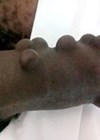Penile size is a major topic for many men and a source of anxiety throughout history. The common belief that a large penis is necessary to impress and satisfy their sexual partners has led to the notion that ‘bigger is better’ [1]. Multiple techniques exist for penile girth augmentation.
These can broadly be divided into non-invasive techniques such as vacuum and traction therapy, surgical procedures such as graft procedures and penile girth enhancement surgery and injectable materials [2,3]. Non-invasive techniques revealed no change in penile girth at three months. The role of surgery for cosmetic penile augmentation is highly controversial given the risk of numerous complications to typically healthy males with functionally normal penises. Thus, penile injectable filler may be viewed as the only reasonable option to many surgeons due to being minimally invasive and promising initial improvements in penile girth. The advancement of numerous alloplastic injectable implants has allowed for non-surgical techniques to be developed for soft tissue augmentation. Multiple studies have reviewed optimal penile filler choices. The main fillers used currently are:
- Liquid silicone
- Autologous fat
- Hyaluronic acid-based hydrogels
- Polymethylmethacrylate-based soft tissue fillers (PMMA)
Liquid silicone injection
Liquid injectable silicone is chemically inert thus can withstand body thermal changes and is an unfavourable medium for micro-organisms. It is widely used in the field of aesthetics for temporary and permanent filler in lips, cheeks, breasts, buttocks and penis. The mechanism of augmentation is believed to occur due to collagen deposition and fibrosis, caused by a non-inflammatory foreign body reaction consisting of multinucleate giant cells and cytoplasmic vacuoles. Injections increase penile circumference by around 3cm [5], however large volumes are required to change girth (100-150ml) [2]. Although believed to be chemically inert, there have been multiple reports of adverse inflammatory reactions in penile injections when compared to other plastic procedures. This may be due to looser fascial planes of the penis and large volumes injected. The complications include silicone migration, penile distortion and late granulomatous reactions. Most of these complications (74%) require surgical management with excision of foreign material with mesh or skin grafts, and in cases requirement for circumcision. It is recommended that radical excision removing all foreign-body liquid is undertaken due to high risk of subsequent complication [4].
Autologous fat filler
The injection of autologous fat filler avoids foreign body reactions associated with alloplastic injectable materials. Injections of 40-68ml of autologous fat into the penile shaft (within dartos fascia) were reported to increase circumference by 2.6cm [2]. However, 90% of the adipocytes injected are reabsorbed or rupture resulting in significantly diminished cosmetic results. Further, there is difficulty in injecting into the correct plane and due to poor blood supply to the injected fat, it frequently can lead to fat necrosis. This results in deformities in curvature or asymmetry as reabsorption / necrosis may not be equal and can lead to calcified fat creating nodules. Additionally, migration of injected fat may still occur. The large volumes of injected fat have led to reports of reduced erectile rigidity due to corporal bodies being overlayed by fat [3]. These complications appear to be permanent regardless of surgical management due to incorporation of injected fat into tissue.
Hyaluronic acid-based hydrogels
Hyaluronic acid-based hydrogels are the favoured choice for penile filler recently. A natural polysaccharide macromolecule typically found in the extracellular matrix of connective tissue, hyaluronic acid is biocompatible, bioactive, non-immunogenic and non-thrombogenic. It is used in both penile shaft and glans. Small scale cohort studies have shown that injectable hyaluronic acid-based gels can significantly increase penile girth (2.27cm) without significant complications [5]. Further, it is reversible with hyaluronidase. Patients in these studies have reported increased satisfaction following their procedure. The main notable complication is diminished tactile sense of the penile body. The limitation for patients is the gels are slowly reabsorbed thus the augmentation is not permanent. It is with associated high costs to patients as requires constant treatment. These costs present a barrier for many patients, who may turn to DIY filler injections with unlicensed alloplastic materials.
Polymethylmethacrylate-based soft tissue fillers (PMMA)
PMMA is a non-absorbable soft-tissue filler that has previously been commonly used for prosthodontics due to its low density, ease of manipulation and cost-effectiveness. For penile augmentation, a filler comprised of micro-spheres of PMMA suspended in vehicles such as bovine collagen or cellulose is used [1]. The microspheres become encapsulated with granulation tissue following injection and develop ingrowth of blood vessels, thus eventually creating ‘living tissue’. Studies have reported increases in penile girth of 2-4cm post-injection, with relatively high satisfaction [1,6]. The effects of augmentation appear to be lifelong. The main complication is irregularities from nodule formation which were noted in 48% of patients [1]. The vast majority of these were managed conservatively, with only 0.4% requiring surgical removal. However, studies to date have only described short-term complications, and no long-term implications are known.
Conclusion
To summarise, various filler options exist but most are associated with complications. Complication rates are likely under-reported due to short follow-up with little review of long-term complication rates [7]. In the experience of the lead clinical author, patients with penile injections such as penile beads, paraffin and silicone have presented with late complications of granulomatous changes many years following injection. These required corrective surgery following multidisciplinary team discussion by andrology specialists through excision of peno-scrotal foreign material with subsequent skin grafting. Furthermore no injectable filler presently has been approved for penile usage by the Food and Drug Administration (FDA) or European Association of Urology (EAU).
Dissatisfaction with penile size has been a longstanding male issue; recommendations for augmentation are even mentioned in the Kama Sutra written over 1500 years ago. Whilst a variety of cross-cultural references to penile enhancement have historically existed, this has been exacerbated by increased intensive media coverage on sexual issues [2]. The growing demand for penile augmentation is likely due to the considerable proportion of men (45%) who are dissatisfied with their penis size in studies, however only 12% had a true micropenis [8]. This is particularly important in a subgroup who suffer from excessive anxiety over penile size known as penile dysmorphic disorder (PDD) or ‘small penis syndrome’. Despite augmentation, multiple studies have reported no change in satisfaction rates for these patients, and where available the satisfaction rates may be arbitrary, thus benefits of these procedures are debateable. Conversely, clinical trials have demonstrated improved symptoms in patients with body dysmorphic disorder (BDD) starting fluoxetine [3]. As PDD is a subset of BDD, there may be evidence of increased satisfaction, although PDD has not been specifically studied. The focus of management of patients with dissatisfaction of normal penis sizes should be around addressing their psychological wellbeing through improving education, and where necessary referral to clinical psychology may be beneficial. Injectables and surgery should remain a last option. At present, the indications to perform cosmetic penile girth enlargement surgery in normal penises remain controversial and no strict guidelines have been proposed. There are plans for published guidance by the EAU on penile augmentation surgery in 2023.
References
1. Casavantes L, Lemperle G, Morales P. Penile girth enhancement with polymethylmethacrylate-based soft tissue fillers. J Sex Med 2016;13(9):1414-22.
2. Vardi Y, Harshai Y, Gil T, Gruenwald I. A critical analysis of penile enhancement procedures for patients with normal penile size: surgical techniques, success, and complications. European Urology 2008;54(5):1042-50.
3. Hehemann MC, Towe M, Huynh LM, et al. Penile girth enlargement strategies: what’s the evidence? Sex Med Rev 2019;7(3):535-47.
4. Svensøy JN, Travers V, Osther PJS. Complications of penile self-injections: investigation of 680 patients with complications following penile self-injections with mineral oil. World J Urol 2018;36(1):135-43.
5. Ahn ST, Shim JS, Bae WJ, et al. Efficacy and safety of penile girth enhancement using hyaluronic acid filler and the clinical impact on ejaculation: a multi-center, patient/evaluator-blinded, randomized active-controlled trial. World J Mens Health 2022;40(2):299-307.
6. Veale D, Miles S, Bramley S, et al. Am I normal? A systematic review and construction of nomograms for flaccid and erect penis length and circumference in up to 15,521 men. BJU Int 2015;115(6):978-86.
7. Romero-Otero J, Manfredi C, Ralph D, et al. Non-invasive and surgical penile enhancement interventions for aesthetic or therapeutic purposes: a systematic review. BJU Int 2021;127(3):269-91.
8. Lever J, Frederick DA, Peplau LA. Does size matter? Men’s and women’s views on penis size across the lifespan. Psychol Men Masculinity 2006;7(3):129-43.
Declaration of competing interests: None declared.










